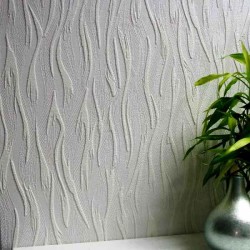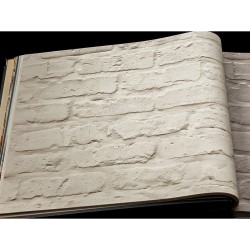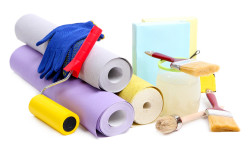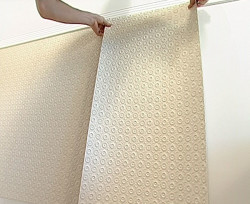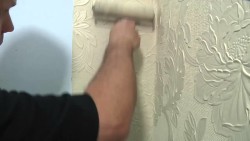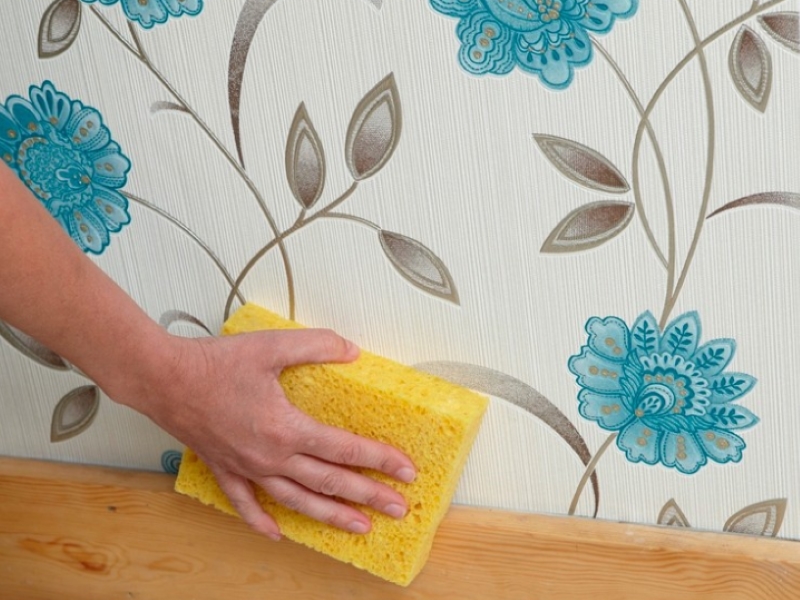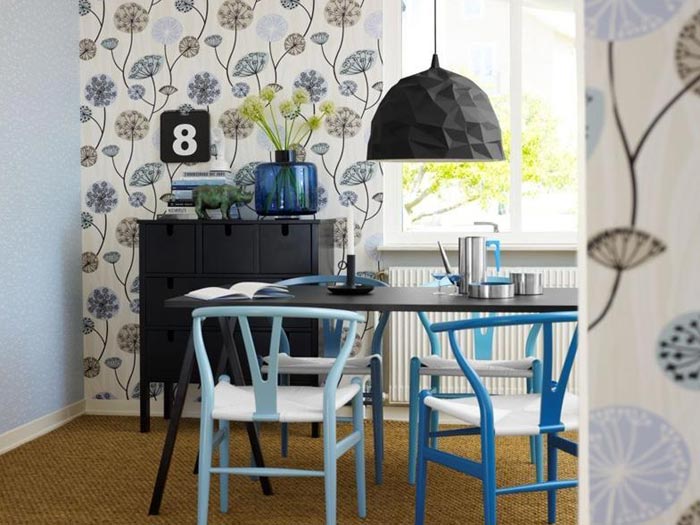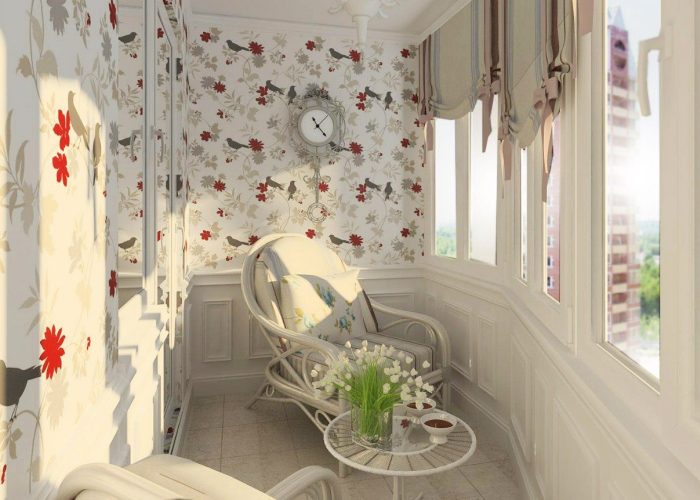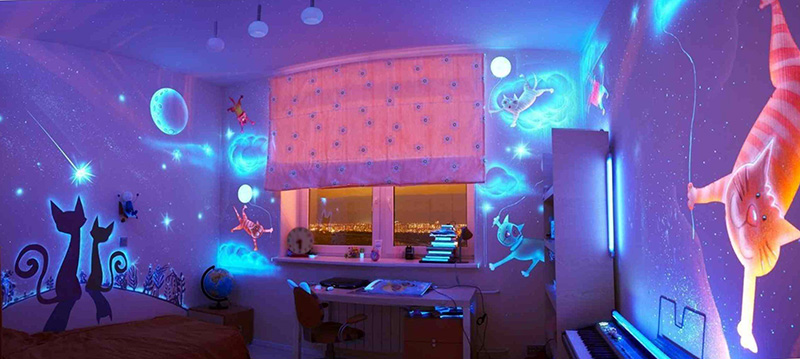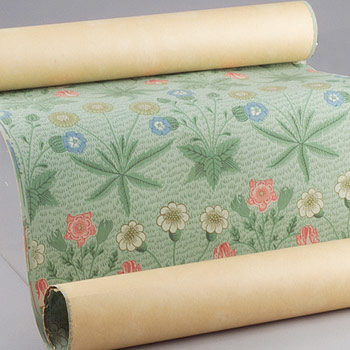Textured wallpapers: selection, sticking and painting
When there is a need simply and quickly create an interesting interiorTextured wallpapers come to the rescue. They differ from ordinary smooth ones. the presence of a relief surface. Depending on the type of wallpaper and production technology, the nature of the pattern can vary significantly. Some wallpapers are sold already painted, others require painting after installation, but in any case, a three-dimensional drawing on the walls will allow you to realize original ideas, and even mask some of the shortcomings of the wall. What should be taken into account when choosing textured wallpapers, gluing and painting them so that the resulting surface meets expectations and is a decoration of the room?
The main types of textured wallpaper
It is impossible to talk about the general properties, advantages and disadvantages of textured wallpaper, because this is a combined concept, which means several types of wallpaper that have a relief. The manufacture and creation of a three-dimensional surface they differ, therefore, the properties are different. For now Textured wallpaper is among paper, vinyl, non-woven wallpaper, glass wallpaper, as well as link crust wallpaper.
Paper textured wallpaper
The simplest and most familiar to many of us paper wallpaper can be textured, moreover A relief pattern can be created in various ways:
 wallpaperingconsisting of two to three layers of paper. Three-layer ones are more expensive, they are more rigid, therefore they allow you to hide small wall defects. Such wallpaper can be impregnated with a water-repellent composition, due to which they receive another valuable property - the possibility of painting;
wallpaperingconsisting of two to three layers of paper. Three-layer ones are more expensive, they are more rigid, therefore they allow you to hide small wall defects. Such wallpaper can be impregnated with a water-repellent composition, due to which they receive another valuable property - the possibility of painting;- coarse fiber wallpaper produced using wood shavings or other natural raw materials, the layer of which is located between two layers of paper. The picture turns out to be chaotic, and it is in this that its charm lies. In addition, such wallpapers are notable for good strength and durability;
- foam wallpaper - two-layer paper wallpapers, on the outside of which is applied a pattern of acrylic foam foamed under the influence of high temperatures.
The assortment of paper wallpapers, without exaggeration, is huge, they are easy to install, environmentally friendly and relatively inexpensive, but in rooms with high humidity (kitchen, bathroom) and increased risk of damage (hallway) they are better not to use.
Vinyl Textured Wallpaper
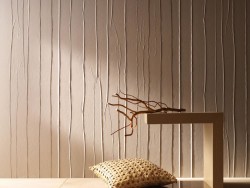 Relief vinyl wallpaper created by cold or hot stamping. A drawing can be absolutely anything: from flowers and patterns to imitating textiles, metal, stone or bricks. This variety allows you to equip the room in any style you want, and thanks to the most voluminous drawings, you can even mask cracks and other irregularities on the walls.
Relief vinyl wallpaper created by cold or hot stamping. A drawing can be absolutely anything: from flowers and patterns to imitating textiles, metal, stone or bricks. This variety allows you to equip the room in any style you want, and thanks to the most voluminous drawings, you can even mask cracks and other irregularities on the walls.
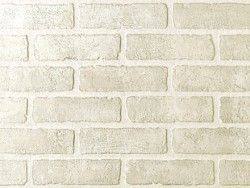 Vinyl wallpapers are made on paper and non-woven basis. The latter is preferable, because it provides higher durability, strength and ease of gluing. In addition to a beautiful appearance, textured vinyl wallpapers have many other advantages, including a higher moisture resistance and even the ability to wash the surface of the material, the absence of shrinkage, resistance to sunlight.The only negative is air tightness, so the room will either have to be intensively ventilated, or use such wallpaper to decorate one or two walls.
Vinyl wallpapers are made on paper and non-woven basis. The latter is preferable, because it provides higher durability, strength and ease of gluing. In addition to a beautiful appearance, textured vinyl wallpapers have many other advantages, including a higher moisture resistance and even the ability to wash the surface of the material, the absence of shrinkage, resistance to sunlight.The only negative is air tightness, so the room will either have to be intensively ventilated, or use such wallpaper to decorate one or two walls.
Non-woven textured wallpaper
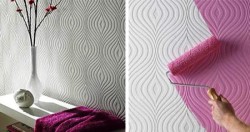 This type of coating is made of several layers of non-woven, the top can have a three-dimensional pattern. Most often, embossed non-woven wallpaper require further staining, and the paint allows you to make the volumetric drawing more durable. Depending on the relief depth the number of possible layers of paint is different and in some cases can reach up to 10, but it is worth remembering that each subsequent layer makes the picture less voluminous and pronounced. As a rule, textured non-woven wallpaper is sold in white.
This type of coating is made of several layers of non-woven, the top can have a three-dimensional pattern. Most often, embossed non-woven wallpaper require further staining, and the paint allows you to make the volumetric drawing more durable. Depending on the relief depth the number of possible layers of paint is different and in some cases can reach up to 10, but it is worth remembering that each subsequent layer makes the picture less voluminous and pronounced. As a rule, textured non-woven wallpaper is sold in white.
Non-woven wallpaper is easy to glue on, it does not stretch or tear, maintainability, air permeability, do not fade in the sun, fireproof and easy to care for.
Cullet
Cullet - material unique in many respects. It is produced from glass melted and stretched into strands, from which a whole web is woven. Special impregnations can get rid of excessive fragility. Cullet always have a volumetric patternTrue, he does not differ in particular pretentiousness: this waves, circles, herringbone, rhombus etc. Manufacturers of this finishing material are constantly replenishing collections with new drawings.
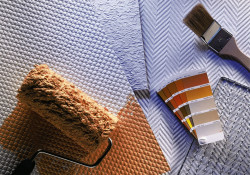 When choosing fiberglass wallpaper, you need to pay attention to the depth of the relief, which directly depends on how many times this material can be repainted. Cullets are often sold colorless, therefore they can be painted in any desired shade. Nevertheless, there are also pre-painted materials on sale, they can also be repainted in the future.
When choosing fiberglass wallpaper, you need to pay attention to the depth of the relief, which directly depends on how many times this material can be repainted. Cullets are often sold colorless, therefore they can be painted in any desired shade. Nevertheless, there are also pre-painted materials on sale, they can also be repainted in the future.
Cullets easily tolerate high humidity, they can even be washed and cleaned, they are durable, durable, non-combustible, they can not only hide small wall defects, but even strengthen them. The unique properties of the material allow it to be used even in bathrooms.
Liquid textured wallpaper
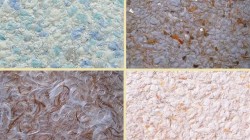 Liquid wallpaper due to the presence of cellulose, silk or cotton fibers in them, they also allow creating an interesting relief surface, which can be compared with the effect of using decorative plaster, because even by the principle of application, these materials are identical. Thanks to the components of the finished mixture, which before use only need to be diluted with water, a certain shade, luster or nacre is obtained. To obtain a more relief surface, you can use a gun to apply the mixture.
Liquid wallpaper due to the presence of cellulose, silk or cotton fibers in them, they also allow creating an interesting relief surface, which can be compared with the effect of using decorative plaster, because even by the principle of application, these materials are identical. Thanks to the components of the finished mixture, which before use only need to be diluted with water, a certain shade, luster or nacre is obtained. To obtain a more relief surface, you can use a gun to apply the mixture.
One of the significant advantages of liquid wallpaper is the ability to create a seamless surface. The structure of the material makes it easy to mask even a few pits and cracks. Moreover, this finishing material allows air to pass through, has good heat- and soundproof properties.
Linkrust wallpaper
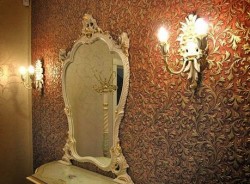 This wallpaper always have a relief surface, which is the value and the main feature of the material. The basis of the material is paper, and the pattern is formed from a mixture of wood flour, chalk, wax, rosin and some other components, they give it relief with special rollers, dies. As a rule, the material has a beige color, and with the help of coloring following installation, you can achieve a delightful decorative effect. Similar wallpapers with many bizarre curls or fancy ornaments are used to decorate individual zones in the room, but are not used to decorate the entire room.
This wallpaper always have a relief surface, which is the value and the main feature of the material. The basis of the material is paper, and the pattern is formed from a mixture of wood flour, chalk, wax, rosin and some other components, they give it relief with special rollers, dies. As a rule, the material has a beige color, and with the help of coloring following installation, you can achieve a delightful decorative effect. Similar wallpapers with many bizarre curls or fancy ornaments are used to decorate individual zones in the room, but are not used to decorate the entire room.
A distinctive feature of this finishing material is the ability only gets stronger over the years. In addition, it is an environmentally friendly, breathable material, resistant to mechanical damage and easy to clean.
Textured Wallpaper Design
The relief of textured wallpaper can be implemented as curls and patterns, to be chaoticwhen it is formed by sawdust, or simulate the surface of other materials. Wallpaper looks great under the brickthat fit into interiors in the style of loft, modern or country. Such material can be used to create a separate zone, ledges or niches, one of the walls in the room. Wallpaper with wood surface imitation fit perfectly into the style of provence, and plaster imitation Suitable for classic interiors. Also used are wallpapers stylized as stone, leather, animal skins.
Making an apartment with textured wallpaper, the main thing is to know the measure and be guided by simple rules:
 large drawings and deep relief visually reduce the area of the room, therefore, in small spaces textured wallpaper should be used carefully, it is better to give preference to materials with a less pronounced pattern and only partially apply them to wall decoration;
large drawings and deep relief visually reduce the area of the room, therefore, in small spaces textured wallpaper should be used carefully, it is better to give preference to materials with a less pronounced pattern and only partially apply them to wall decoration;- It is better not to use textures of different types in the same room;
- interesting effects can be achieved using textured wallpapers in trim the bottom or top of the wall or framing fragments of such wallpaper with decorative moldings;
- It is better to combine plain textured materials with textured wallpaper.
Designers advise using in the bedroom textured wallpaper with a slightly noticeable texture, so as not to burden the space for relaxation. In the living room you can give free rein to fantasy, but in the hall and in kitchen work area textured wallpaper is inappropriate, since it is more difficult to remove dirt from volumetric elements.
Sticking Textured Wallpaper
Decorating the interior with textured wallpaper is quite simple, and you can do it yourself. The installation process is as follows:
 surface preparation. First remove the old coating. Despite the fact that textured wallpaper can hide individual wall defects, it is better to get rid of large cracks and pits before gluing and level surface. Small defects and irregularities can be repaired with putty, larger ones - stucco, and in the most advanced cases use drywall;
surface preparation. First remove the old coating. Despite the fact that textured wallpaper can hide individual wall defects, it is better to get rid of large cracks and pits before gluing and level surface. Small defects and irregularities can be repaired with putty, larger ones - stucco, and in the most advanced cases use drywall;- wall marking or part thereof. This step is optional, but desirable to facilitate the installation process and improve the final result. From the corner of the room or another place from which wallpapering will begin, a length equal to the width of the canvas is laid off. A vertical line is drawn along it with the help of the level, from which the roll width is again measured and the procedure is repeated;
 wallpaper cutting. Given the height of the wall and adding a few centimeters to allowances, fragments of wallpaper are cut. It is not superfluous to pre-measure the height of the ceiling in different places in order to properly cut the wallpaper. On the packaging, the manufacturer usually indicates how many centimeters should be left on stock allowance. The larger the picture, the more waste will be when gluing, which is worth considering when buying. Cullets are best cut into personal protective equipment, as tiny glass particles can get into the respiratory tract. After cutting, the wallpaper of linkrust is twisted into rolls and soaked in hot water, then left to dry for 10 hours;
wallpaper cutting. Given the height of the wall and adding a few centimeters to allowances, fragments of wallpaper are cut. It is not superfluous to pre-measure the height of the ceiling in different places in order to properly cut the wallpaper. On the packaging, the manufacturer usually indicates how many centimeters should be left on stock allowance. The larger the picture, the more waste will be when gluing, which is worth considering when buying. Cullets are best cut into personal protective equipment, as tiny glass particles can get into the respiratory tract. After cutting, the wallpaper of linkrust is twisted into rolls and soaked in hot water, then left to dry for 10 hours;- glue preparation. For each type of wallpaper, it is better to use a special glue, for glass wallpaper, a glue intended for vinyl wallpaper is also suitable, for linkrust wallpaper the glue is prepared on the basis of flour paste and wood glue;
 glue application can be made on the wallpaper itself or on the wall. Paper wallpaper after applying glue to them is left for 5 minutes for impregnation, when gluing non-woven and glass wallpaper, the glue is applied to the wall. Vinyl wallpapers are mounted depending on the type of base, the details are indicated on the packaging, and when installing the wallpaper of the linkrust, the wall and the material are glue;
glue application can be made on the wallpaper itself or on the wall. Paper wallpaper after applying glue to them is left for 5 minutes for impregnation, when gluing non-woven and glass wallpaper, the glue is applied to the wall. Vinyl wallpapers are mounted depending on the type of base, the details are indicated on the packaging, and when installing the wallpaper of the linkrust, the wall and the material are glue;- installation process. They begin to glue the wallpaper from the corner of the room from top to bottom, pressing the canvas and gently smoothing the roller from the center to the edges. Textured wallpapers are glued butt, the joints of wallpaper rolled roller.The wallpaper of the linkrust after gluing is additionally fixed with a wooden lath, after removing which the holes are putty;
- after drying excess wallpaper cut off with a spatula and knife.
Liquid wallpaper They are prepared from a special mixture by adding water and applied to a previously prepared surface, like conventional plaster, with a spatula, grater or spray gun.
Painting textured wallpaper
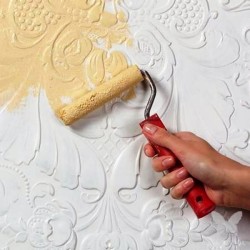 When the wallpaper is completely dry, you can proceed to painting. The process is simple and does not differ from ordinary wall painting. You only need to prepare a paint of a certain shade or tint a sufficient mass in advance and get to work. Apply her better rollerto better color the embossed wallpaper pattern. Each subsequent layer of paint is applied after drying of the previous one, until the desired shade is reached. Textured wallpaper allows you to experiment with a combination of paints of different colors, which emphasizes the unique pattern of the material.
When the wallpaper is completely dry, you can proceed to painting. The process is simple and does not differ from ordinary wall painting. You only need to prepare a paint of a certain shade or tint a sufficient mass in advance and get to work. Apply her better rollerto better color the embossed wallpaper pattern. Each subsequent layer of paint is applied after drying of the previous one, until the desired shade is reached. Textured wallpaper allows you to experiment with a combination of paints of different colors, which emphasizes the unique pattern of the material.
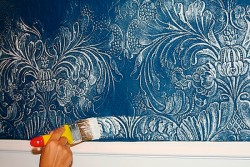 For non-woven wallpaper, water-dispersion paints are suitable, for glass wallpaper - compounds that are resistant to washing, including acrylic and latex paints; for wallpaper lincrust - oil, acrylic paints, as well as wax paste.
For non-woven wallpaper, water-dispersion paints are suitable, for glass wallpaper - compounds that are resistant to washing, including acrylic and latex paints; for wallpaper lincrust - oil, acrylic paints, as well as wax paste.
In conclusion
Properly selected and pasted textured wallpaper can be a real decoration of the room. Having shown imagination, you can find them a worthy place in the room, and coloring will be the last touch and the ability to quickly change the atmosphere. To keep such a coating clean, you will need to periodically vacuum it or wipe it with a damp cloth.

